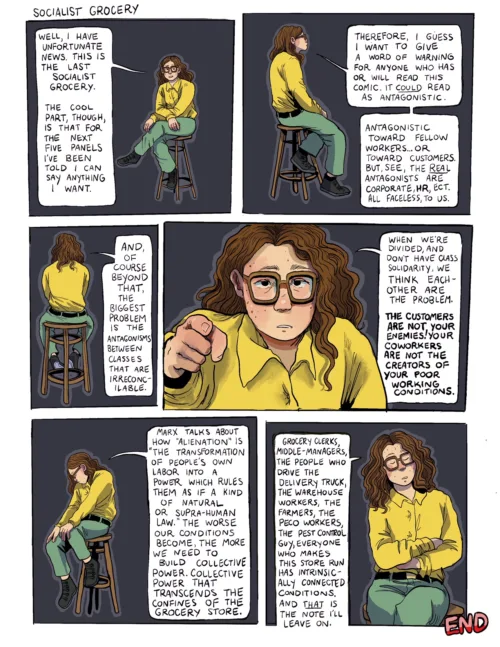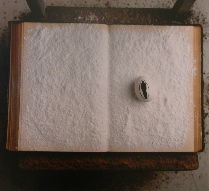
Puerto Rican artist Victor Vazquez’s new photographs and video at Seraphin Gallery express relationships about body, land and spirit in ways both foreign and familiar.
In multi-panel works, the artist photographs common materials — a chair, an egg, a metal bucket, some dirt — and creates a world of beautiful disorientation.
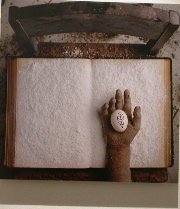
“Chair and Book,” for example, is work of sumptuous textures and inviting richness. Yet the sequence of photographs of a large book, a wooden chair and an egg are a puzzle. (first two images, from “Chair and Book” sequence)
The book is covered with snowy white powder — I thought it was flour but the artist said baby powder. The chair and floor are covered with a rich brown dirt; there’s a mud-caked hand holding an egg that has a drawing of a mummy-like figure on it. Everything, from the brown and white colors and the open book and the chair, made me thing of kitchen and baking (I must have been hungry). But the clearer reference was to learning, anthropology and ritual. All I really know is it’s loveliness is not lyrical, although there is poetry in it.
There’s a kind of haiku-like spareness to the work and an almost mathmatics-like precision, yet I am not sure what a and b add up to. But their gorgeousness and their iconic nature make you accept them as objects.

“Bucket Man” (left and below) is a sequence showing a mud-covered model with his head in a bucket or standing to face the viewer. Either way, the set-up is evocative. This is no Muybridge sequence. Motion is not the point, although it is suggested.
The point seems to be, again, ritual and performance. The figure bent over the bucket is all acute angles and suggests a kind of animal quality — chicken, even. As for the standing model, he looks like a kind of acolyte or perhaps a holy fool.
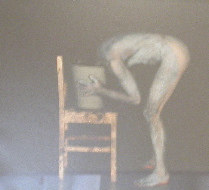
“Blood with Candle” (below) reminded me of Gerhard Richter’s photographic paintings of tall tapers burning. But Vazquez’s candle is sandwiched between two images of a blood-spattered wall. The chicken blood, the candle, the hand holding it are all startlingly beautiful, which jars your thoughts as you imagine how the blood got on the wall.

As you walk back and forth studying all these images, metaphors for learning, stability, humanity seem to be suggested. But the iconic works are complete unto themselves, and they really don’t need the viewer to complete them.
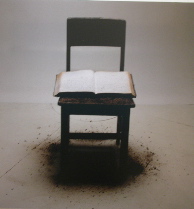
Vazquez, is an artist fueled by his study of comparative religions. He has spent time in both Japan and India.
Previous photographs focused more directly on the Caribbean practice known as Santaria. Here, the work suggests it (blood, dirt, mud) but the artist seems to be pushing elsewhere, into the interplay between east-west cultures. And it — almost — suggests a kind of harmonious coexistence.
This is most clear in his untitled three-channel video piece, (below) which juxtaposes a city ritual and a country ritual. Here, on old fashioned, blue-tinted monitors you see a close up shot of a man’s feet walking towards you. First, the feet are in fashionable shoes walking on a city street; then the scene shifts and the feet — bare — tread a stretch of rocky and occasionally muddy land, perhaps a road. It’s not clear.
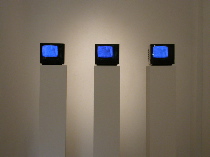
The contrast between the bare feet squishing and sinking in mud and the wingtip-encased feet pounding the pavement suggests not a clash of cultures but a kind of oneness in difference.
Bottom line, these works tringulate like haikus, all sideways glances and inference.
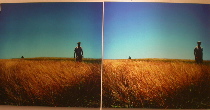
More to the point, they seem a part of a kind of pre-verbal or anti-verbal world. Their power lies knotted up in ur-threads of thought that best be left tangled.
I always want to untangle things. But I find that Vazquez’s works are so firmly rooted and so beautiful and odd, that I’m happy to meet them on their turf, tangles and all. (bottom image is from series “Man Walking”)
Also showing at Seraphin, Leon Golub’s large paintings and drawings. More on those another day.






